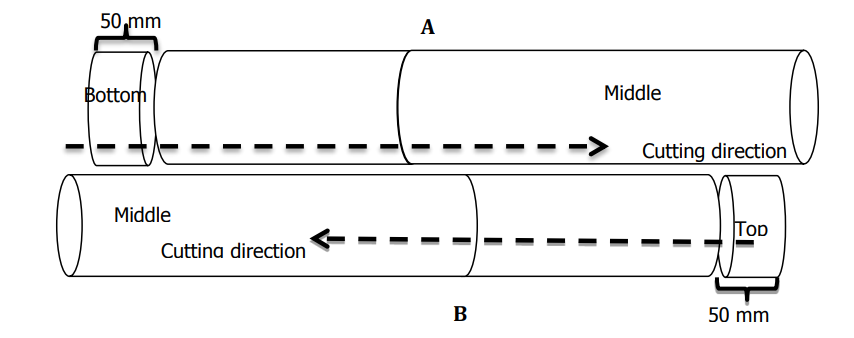Several physical properties of Eucalyptus pellita F. Muell from different provenances and sampling position on tree

Eucalyptus pellita F. Muell is one of the species selected for the development of the plantation forest in Indonesia. In order to obtain a superior plant for the continuity of the plantation forest program, various tree breeding techniques are often applied, one of which is through best provenance selection. Conventional or advanced tree breeding program generally aims to obtain a fast-growing plant with good physical appearance. The program rarely gives attention to the properties/characteristics of timber produced. This aspect becomes the main background of this particular study which aims to investigate the effect of four provenances and also to examine the effect of sampling position on the trees on several physical properties of E. pellita. The result showed that the highest moisture content (97.34 + 15.67%) was found in the bottom part of trees from Indonesia provenance. While, the highest air-dry moisture content (15.15 + 0.20%) was observed in the top-part samples from Provenance North Kiriwo PNG. Samples from Provenance Serisa Village PNG have the highest density ranges, approximately 590 + 90 kg/m3 and 630 + 80 kg/m3 in the bottom-part samples and in the top-part samples, respectively. The highest T/R ratio, approximately 1.91 + 0.26, was observed in the bottom[1]part samples from Provenance South Kiriwa, PNG. The T/R ratio values of all provenances were less than 2, indicating the lumber will be possibly stable during its uses or further processing. Further result showed provenance factor significantly affect initial moisture content and density. Sampling position on trees only affect affects the initial moisture content. Based on the results, the timber of E. pellita being examined can be further used for light-to-medium construction purpose.
Basri, E. (2011). Kualitas kayu waru gunung (Hibiscus macrophyllus Roxb.) pada 3 kelompok umur dan sifat densifikasinya untuk bahan mebel (Thesis). Yogyakarta: Universitas Gadjah Mada.
Basri, E, Saefudin, Rulliyati, S, & Yuniarti, K. (2009). Drying conditions for 11 potential ramin substitutes. Journal of Tropical Forest Science 21(4): 328-335. doi: https://www.frim.gov.my/v1/JTFSOnline/jtfs/V2 1n4/328-335.pdf.
Bristow, M. (2008). Growth of Eucalyptus pellita in mixed species and monoculture plantations (Thesis). Lismore, New South Wales: Southern Cross University.
BSI. (1957). British Standard 373-157: Methods of Testing Small Clear Specimens of Timber. London.
Cáceres, CB, Hernández, RE, & Fortin, Y. (2017). Shrinkage variation in Japanese larch (Larix kaempferi, [Lamb.]Carr.) progenies/provenances trials in Eastern Canada. Wood Material Science & Engineering: 1-7. doi: 10.1080/17480272.2017.1327460.
Direktur Jenderal Perdagangan Luar Negeri. (2017). Peraturan Kementerian Perdagangan Republik Indonesia 59/M-DAG/PER/8/2017: Penetapan harga patokan eskpor atas produk pertanian dan kehutanan yang dikenakan bea keluar.Jakarta.
Frederick, DJ, Madgwick, HAI, & Oliver, GR. (1982). Wood basic density and moisture content of young Eucalyptus regnans grown in New Zealand. New Zealand Journal of Forestry Science 12(3): 494-500. doi: http://citeseerx.ist.psu.edu /viewdoc /download?doi=10.1.1.705.7772&rep=rep1&type =pdf.
Haggman, H., Sutela, S, & Fladung, M. (2016). Genetic engineering contribution to forest tree breeding efforts. In: Biosafety of Forest Transgenic Trees. Netherland: Springer.
Hii, SY, Ha, KS, Ngui, ML, Ak Penguang, S, Duju, A, Teng, XY, & Meder, R. (2017). Assessment of plantation grown Eucalyptus pellita in Borneo, Malaysia for solid wood utilisation. Australian Forestry 80(1): 26-33. doi: 10.1080/00049158.2016.1272526.
Hopewell, GP, Atyeo, WJ, & McGavin, RL. (2008). Evaluation of wood characteristics of tropical post mid rotation plantation Eucalyptus cloeziana and E. pellita : part (d) veneer and plywood potential. Research Report. Melbourne, Australia: Forest and Wood Products Australia (Unpublished).
Knapic, S, Louzada, JL, Leal, S, & Pereira, H. (2008). Within-tree and between-tree variation of wood density components in cork oak trees in two sites in Portugal. Forestry: An International Journal of Forest Research 81(4): 465-473. doi: 10.1093/forestry/cpn012.
Leksono, B. (2016). Seleksi Berulang pada Spesies Tanaman Hutan Tropis untuk Kemandirian Benih Unggul. Bogor: Badan Penelitian, Pengembangan dan Inovasi.
Lukmandaru, G, Zumaini, UF, Soeprijadi, D, Nugroho, WD, & Susanto, M. (2016). Chemical properties and fiber dimensions of Eucalyptus pellita from the 2nd generation of progeny tests in Pelaihari, South Borneo, Indonesia. Journal of Korean Wood Science Technology 44(4): 571-588. doi: https://www.cabdirect.org/cabdirect/abstract/2 0163271766.
Martawijaya, A, Kartasujana, I, Kadir, K, & Prawira, SA. (2005). Atlas Kayu Indonesia (3rd ed.). Bogor: Center for Forest Products Research and Development.
McGavin, RL, Bailleres, H, Fehrmann, J, & Ozarska, B. (2015). Stiffness and density analysis of rotary veneer recovered from six species of Australian Plantation Hardwoods. Bio Resources, 10(4), 6395 – 6416. doi: HTTP: //ojs.enr.ncsu.edu/index,PhP/BioRes/article/vie w/BioRes_10-4_6394_McGavin_Stiffness_Density_ Analysis_Rotani_Venerr/4272.
Nadalia, D. (2013). Model keterkaitan produksi Eucalyptus pellita dengan karakteristik lahan sebagai dasar penyusunan kriteria kesesuaian lahan (Thesis). Bogor: Institut Pertanian Bogor.
Nirsatmanto, A, Setyaji, T, Sunarti, S, & Kartikaningtyas, D. (2015). Genetic gain and projected increase in stand volume from two cycles breeding program of Acacia mangium. Indonesian Journal of Forestry Research 2(2): 71-79. doi: http://ejournal.forda-mof.org/ejournal litbang / index.php /IJFR /article /view /1521 /1357.
Panshin, AJ, & De Zeeuw, CJ. (1980). Textbook of Wood Technology. New York: McGraw-Hill Book Company.
Quang, TH, Kien, ND, von Arnold, S, Jansson, G, Thinh, HH, & Clapham, D. (2010). Relationship of wood composition to growth traits of selected open-pollinated families of Eucalyptus urophylla from a progeny trial in Vietnam. New Forests 39(3): 301- 312. doi: 10.1007/s11056-009-9172-5.
Setyaji, T, Sunarti, S, & Nirsatmanto, A. (2016). Early growth and stand volume productivity of selected clones of Eucalyptus pellita. Indonesian Journal of Forestry Research 3(1): 27-32. doi: http://ejournal.forda-mof.org/ejournal-litbang /index.php/IJFR/article/view/1578.
Sulichantini, ED. (2016). Pertumbuhan tanaman Eucalyptus pellita F. Muell di lapangan dengan menggunakan bibit hasil perbanyakan dengan metode kultur jaringan, stek pucuk dan biji. Zira'ah 41(2): 269-275. doi: https://ojs.uniska bjm.ac.id/index.php/ziraah/article/view/430.
Yuniarti, K. (2017a). The mechanosorptive behaviour of wood during intermittent drying. Final report: ACIAR project no C2015/250. Research Report. Bogor: Forest Products Research and Development Center. (Unpublished).
Yuniarti, K. (2017b). Pengaruh pohon induk dan posisi sampel pada batang pohon terhadap beberapa sifat fisis mangium (Acacia mangium Willd) usia 4 tahun Paper presented at the Seminar Masyarakat Peneliti Kayu Indonesia (MAPEKI) XX, Denpasar, Bali, 26-29 September.

